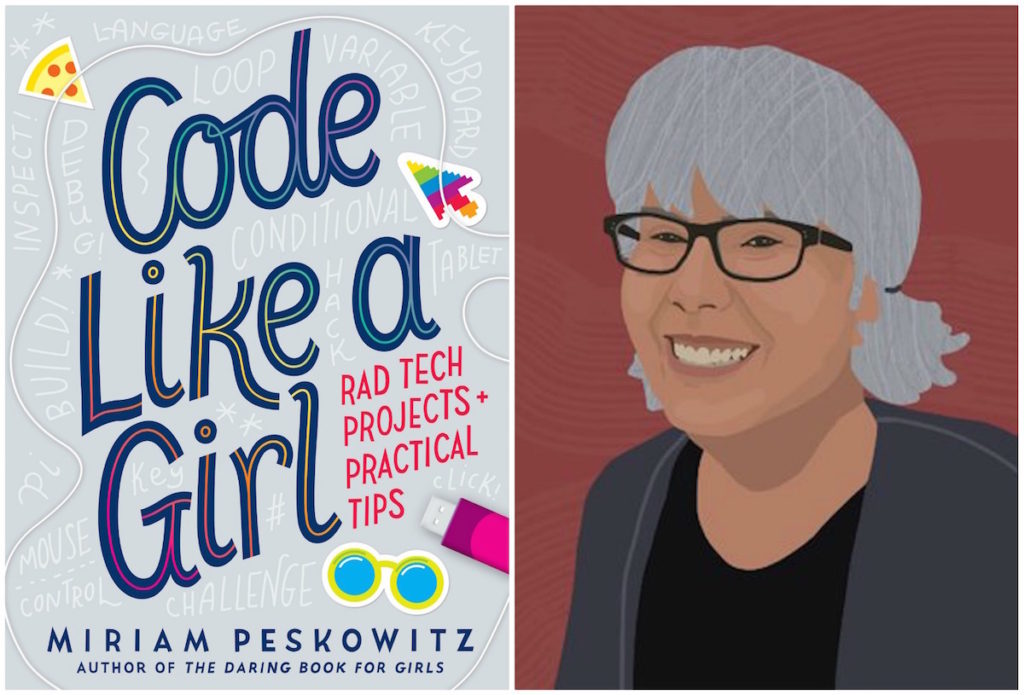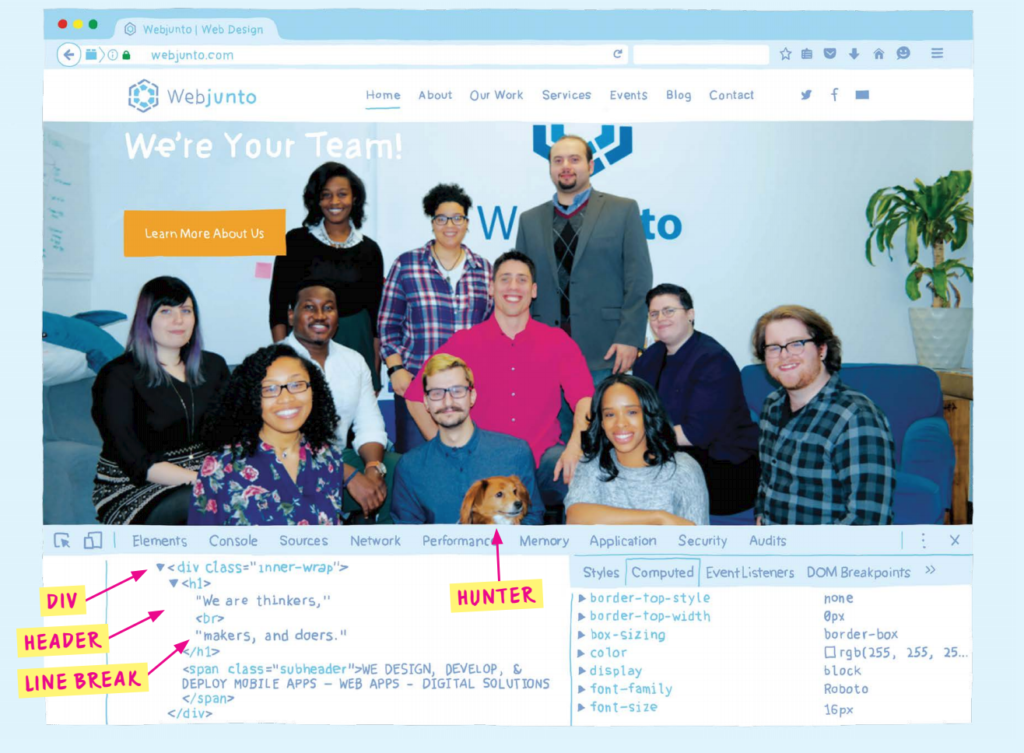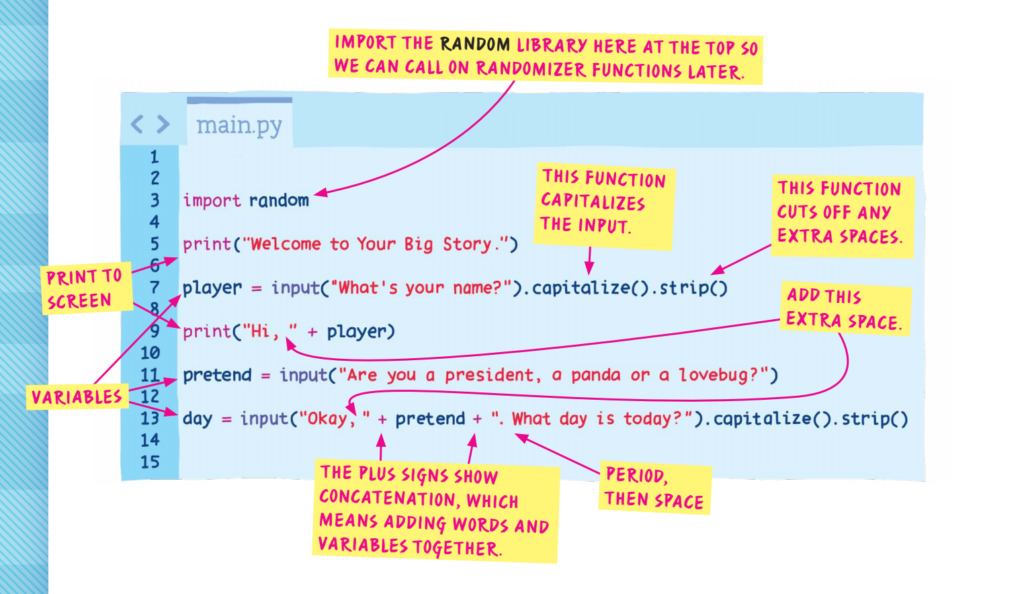
Author Miriam Peskowitz’s new book Code Like A Girl is a fresh take on learning to code, starting with Scratch, running through Python (via Trinket!), and ending with Raspberry Pi computers. Miriam first contacted us a few years ago about her project, and it’s been fun to get some glimpses behind the scenes as she’s worked to make her vision a reality.
She sat down with us on the day her book was released to discuss her approach to coding, her experiences with the coding education as a woman and a mother, what she wanted for the book, and her vision for what coding like a girl means. Our talk definitely left me inspired, and I hope it does the same for you!
Code Like A Girl is your 6th book. How did you become an author?
So, I spent my 20s in graduate school, at Duke, and then put in a few more as a young professor at the University of Florida. By 34 I’d gotten tenure and had a baby and took a leave of absence. I realized I’d done the academic things I wanted to do, and that what I loved about the job was creating new things through writing. I decided to follow that instinct. I gave up tenure and got to work on my first post-academic book. I’m glad for those academic experiences; they made me fearless about exploring new ideas and fields, and using all the words you get to put into a book to bring them alive.
This book in a sense builds on your Daring Books for Girls series. What made you want to write this book now?
Well, first, I saw my high school age daughter take coding classes. Semester 1 was 50/50 boys and girls. Semester 2 was 70/30 and by Semester 3 she was the only girl in the class and all the boys were getting together and sharing code. It has started well, but turned into the classic experience. Then, true story, I was called to the Obama White House for some meetings about girls, media, toys and tech, and I left that day thinking there was a book to be written, and that even though I knew nothing more than a little html at the time, I wanted to learn to code and write it.
Wow! It sounds like maybe you realized that your daughter’s experience was something that girls everywhere might have to run into, and something you might be able to address with this book?
Not every single girl experiences this, for sure, but many do. Coding has become a “guy thing.” I went to a React conference last spring, and there were 3 women and about 200 men. It felt like performance art to walk in the room! Just today I heard a girl talk about going to summer camp, and how you have to choose. There’s coding camp and sports camp and general camp. She wanted to go to coding camp, but it was all boys, and so she didn’t go, and now she regrets it, and she knows it’s not just her. It’s widespread, but it’s actually pretty easy to change to make room for everyone.

Is your book only for girls? If not, who is it for?
In tech, at this moment, men are at the center. In Code Like a Girl, I wanted to create a diverse tech world with girls at the center. That’s why early on, there’s a picture of the Webjunto team. That’s why the images of girls are multiple and diverse. Code is code, though. The book is for everyone, any age, any gender, who has ever wondered how code works and where to start. And I guess, who can pick up a book with “Girl” in the title!
What might coding like a girl mean for men and boys? In other words, how might approach you take in your book change coding if everyone adopted it?
It’s hard to talk about this without going into stereotypes, right? There are lots of types of men, and women, and trans and queer and nonbinary people. So the answer is not that coding like a girl will mean we’re nicer, or more creative, or we all wear nail polish, or whatever, but what it means we’ll operate differently and be open to change. To code like a girl might mean that boys and men in tech notice and think about what it means that most tech teams and classrooms and coding programs are mostly men, that they don’t have to feel defensive about it, they can just be part of opening things up for girls, women and all people of color. You know what I mean? It might also mean coming to terms with the “insider” feel of some of tech culture, because that will change.
Absolutely. That’s a really inspiring vision for the future of tech and coding specifically.
“The book isn’t just about code: it’s about coding with friends, about patience, about frustration, about that feeling we all have: are we smart enough to learn this?”
There are so many resources for coding education, both online and in print. What influenced your approach to creating Code Like a Girl?
While I was writing, I couldn’t stop thinking about whether a book was a good way to learn code, which meant I had to figure out why it was. I think with books we can slow down, we can turn pages back and forth, look for what we need. I worked with designers and editors, and came up with the magic of arrows and labels and captions, all the ways we can point attention to pieces of code, without having to read dense paragraphs.
Here’s the thing, though. The secret of the book is tone. There are lots of ways to be a kid, a girl, a woman, and I wanted to write with a tone that felt warm and welcoming, and that was fun and big-world. The book isn’t just about code: it’s about coding with friends, about patience, about frustration, about that feeling we all have: are we smart enough to learn this? Will it ever make sense? Code has become such an unfamiliar place to many girls. I wanted to write in a way that made code feel recognizable, girlish in addition to boyish, and everywhere in between.
The meticulously designed graphics you mentioned above make the book incredibly visual and engaging. How did you come up with these designs and why do you and your editorial team spend so much time on them?
Well I started with colorful screenshots from Scratch and Trinket.io… and my editorial team worked with the talented Sara Corbett on design. Here’s the thing: I wanted a beginner of any age to understand code. Once we did the first layout, it was clear that lots of paragraphs needed to become arrows and labels and captions. I wanted to be able to show a reader exactly what the code for a given project was doing. For example, the concept of a variable is very abstract, but an illustration of a big book in a box can make it more clear– the box is the variable, the book is the value, which can change. I’ll tell you, though, It took longer to create and edit and re-edit all the labels than it did to write the book!

You have such a unique background. How did you become a coder?
I started the way any interested person would, with all the online tutorials. Early on I knew that it didn’t matter what language I learned, it was a process. Girl Develop It Philly was an active chapter and offered several workshops a month, and I was at most of them. I went to meetups and hackathons and any local classes I could find. Then I took a longer course in JavaScript, and then I signed on for the whole-deal full stack online program at Flatiron School.
What was learning to code at Flatiron like for you?
I loved it, it was so hard. That’s the thing I love about code, it’s difficult and magical all at the same time. I’m still finishing up the program, actually. When you start with Ruby, then do Sinatra, Rails, some HTML and CSS and go all through JavaScript and end in React and Redux, well that’s a lot of code and projects to work through.
Flatiron’s founder, Avi Flombaum, comes out of creative writing, so I feel like I got to learn code as language. I did Flatiron’s full stack online program, and it was so active. I was always in study groups or on screenshare with the tech coaches. There are about 50% women in the program, and people from all over the world. The school nails that balance of kind and rigorous that so many of us aim for in teaching and school. Now that my book is out, I’m ready to finish my final two projects and graduate.
I love that: you put your final projects on hold to write your book. It seems like you’re very well-prepared to finish those projects now.
You’re making a big impact in coding education, but you’re not a teacher. Do you have any suggestions for others who want to get involved with coding in similarly creative ways?
Great question. Code Like a Girl talks about code as part of telling your story. I think code is a whole imaginative world, and I’d urge everyone who teaches or creates in any way to start learning, because knowing it, you can become a part of new conversations, and you never know where that can lead.
Your story, and your book, are proof of that for sure!
What are you working on next?
We’ll we’re working on a Code Like a Girl of Code activity, so people can look for that on Trinket’s hourofpython.com site this Fall!